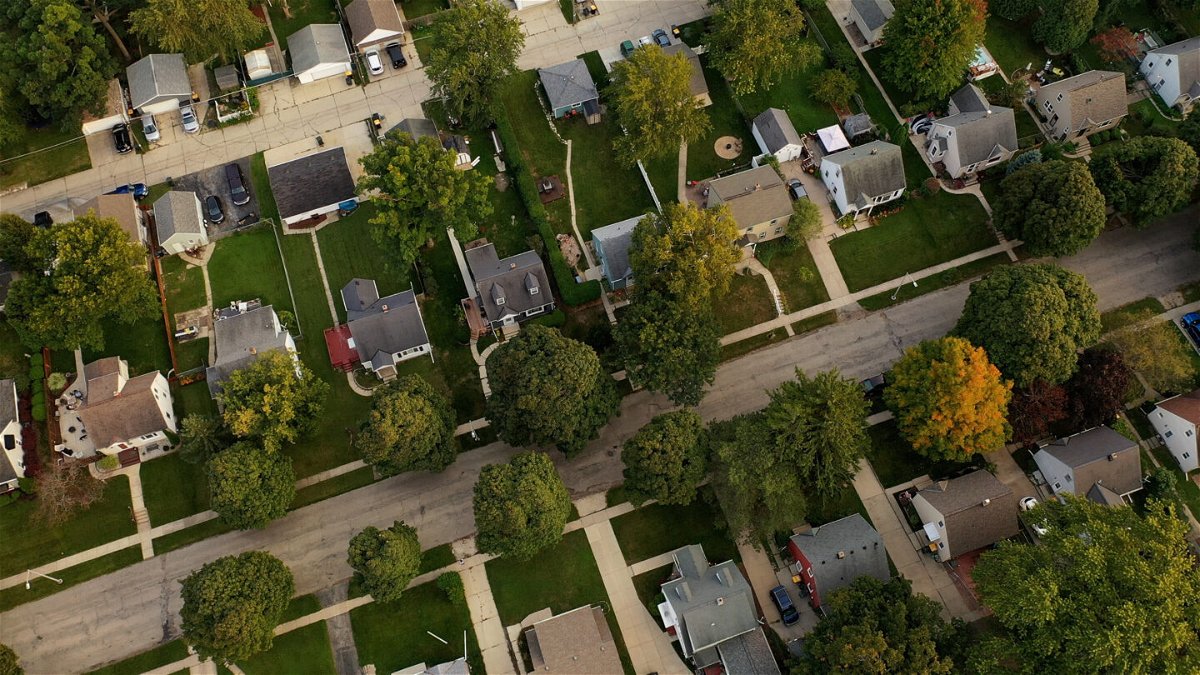Mortgage giants raise loan limits to a record level for 2023

Fannie Mae and Freddie Mac will back loans of more than $1 million. Pictured is an aerial view of a suburban neighborhood in the United States.
By Anna Bahney, CNN Business
Mortgage giants Fannie Mae and Freddie Mac will raise the limits of government-backed loans to a record level for 2023, with the maximum loan limit hitting more than $1 million for high-cost areas, the Federal Housing Finance Agency announced Tuesday.
Even as the real estate market has cooled in the face of skyrocketing mortgage rates this year, home prices are still climbing, with prices up 12.21% in the third quarter compared to a year ago, according to FHFA.
As a result, the baseline conforming loan limit for 2023 will be $726,200, up $79,000 from this year’s limit of $647,200. Higher-cost areas will have a new loan limit of $1,089,300, or up to 150% of the baseline loan limit. This year, the loan limit for high cost areas is $970,800.
Mortgages above these loan limits are considered “non-conforming” or “jumbo” mortgages, and typically come with higher interest rates.
Next year’s increases are not as large as those put in place for 2022. That’s largely because of slowing home price growth. The increase for 2022, which was up $98,950 from $548,250 in 2021, was the largest percentage increase and dollar increase going back to 1980.
“The rate of US house price growth has substantially decelerated,” said William Doerner, supervisory economist in FHFA’s division of research and statistics. “This deceleration is widespread with about one-third of all states and metropolitan statistical areas registering annual growth below 10%.”
The increase is welcome news for homebuyers, especially those in high-cost areas who have been pushed into pricier jumbo mortgages, even for a modest home.
“These new, much higher numbers will enable more homebuyers to take advantage of Fannie Mae and Freddie Mac financing,” said Melissa Cohn, regional vice president at William Raveis Mortgage.
But not all in the housing industry agree that expanded limits are a good idea.
The Housing Policy Council, a trade association of mortgage lenders and servicers, insurers, and technology and data companies, argues that higher loan limits can make the affordability crisis worse. With home prices rising much faster than household income, taxpayer backing of bigger loans provides a subsidy that results in slightly lower mortgage rates which, in turn, encourages people to buy more expensive homes.
“Ultimately, such backing feeds the run-up in house prices, exacerbating the affordability challenges we face in today’s supply-constrained marketplace,” the HPC said in a statement.
What are conforming loan limits?
Fannie Mae and Freddie Mac back about half of all US mortgages, but they are not lenders. Instead, Freddie and Fannie buy loans from lenders and sell them to investors. That makes those loans cheaper for lenders and keeps credit available and relatively affordable to consumers, among other benefits.
The baseline loan limit is the highest loan amount — not the purchase price — for a one-unit purchase.
By categorizing higher-balance loans as conforming, more homebuyers can qualify for loans that are typically less expensive, require smaller down payments and allow for lower credit scores. Jumbo loans are more expensive and harder to qualify for because of the higher risk they carry.
The FHFA’s formula for boosting the limits each year looks at how much home prices have grown during the year. The law establishes the maximum loan limit in high-cost areas as a multiple of the area’s median home value, up to a maximum of 150% of the baseline loan limit.
High-cost cities include areas like San Francisco and Silicon Valley, as well as New York City and Washington, DC, and the cities’ surrounding suburbs.
It is FHFA’s practice not to allow loan limits to decrease. When home prices decline, loan limits remain the same as the prior year until house price declines have been “made up.” For example, following the housing crash, the baseline loan limit value did not change in 2007 and remained at the same level until 2017, when they increased again.
The-CNN-Wire
™ & © 2022 Cable News Network, Inc., a Warner Bros. Discovery Company. All rights reserved.